EFFECTIVE ASSESSMENT OF PAIN RELIEF AFTER THORACIC SURGERY OF PATIENT CONTROLLED EPIDURAL ANALGESIA (PCEA) METHOD COMPARED WITH THE CONTINOUS EPIDURAL INFUSION (CEI) METHOD
Main Article Content
Abstract
In thoracic surgery, postoperative pain will reduce the patient's motor function, adversely affect lung function, increase the rate of postoperative complications, and potentially chronic pain syndrome after surgery. Thoracic epidural analgesia is often considered the gold standard for pain management after thoracic surgery. We conducted a study to evaluate the effectiveness of pain relief after thoracic surgery of the Patient Controlled Epidural Analgesia (PCEA) method compared with the Continuous Epidural Infusion (CEI) through the epidural catheter with a mixture of bupivacaine and fentanyl. The study method was a randomized controlled clinical intervention study carried out from June 2021 to September 2021, on 63 patients randomly divided into 2 groups: Group I – patients were received postoperative pain relief by PCEA; group II- patients were received postoperative pain by CEI method. Research results show that PCEA and CEI methods through epidural analgesia catheter in thoracic surgery have good pain relief both at rest and at movements, with few side effects. Furthermore, the PCEA method uses less pain reliever and the patient has more rapid pain control compared with CEI.
Article Details
Keywords
thoracic surgery, epidural anesthesia, patient control analgesia
References
2. Yegin, A (2003). Early postoperative pain management after thoracic surgery; pre- and postoperative versus postoperative epidural analgesia: a randomised study. European Journal of Cardio-Thoracic Surgery, 24(3), 420–424.
3. Boyle, Patrick K. (2010). Rajʼs Practical Management of Pain, Fourth Edition.. Anesthesiology, 112(1), 257–258.
4. Ferrante, F. Michael; Lu, Louise; Jamison, Stephen B.; Datta, Sanjay (1991). Patient-Controlled Epidural Analgesia. Anesthesia & Analgesia, 73(5).
5. Đức NT. Đánh giá hiệu quả giảm đau sau mổ ung thư trực tràng bằng hỗn hợp bupivacaine và fentanyl qua catheter ngoài màng cứng do bệnh nhân tự điều khiển và truyền liên tục, Trường Đại học Y Hà Nội; 2007.
6. Behera B, Puri G, Ghai B. Patient-controlled epidural analgesia with fentanyl and bupivacaine provides better analgesia than intravenous morphine patient-controlled analgesia for early thoracotomy pain. Journal of postgraduate medicine. 2008;54(2):86.
7. Özalp G, Güner R, Kuru N, Kadiogullari N. Postoperative patientcontrolled epidural analgesia with opioid bupivacaine mixtures. Canadian journal of anaesthesia. 1998;45(10):938-942.
8. Liu S.S et al. Patient-controlled epidural analgesia with bupivacaine and fentanyl on hospital wards: Prospectiveexperience with 1030 surgical patients. Anesthesiology. 1998;88.


